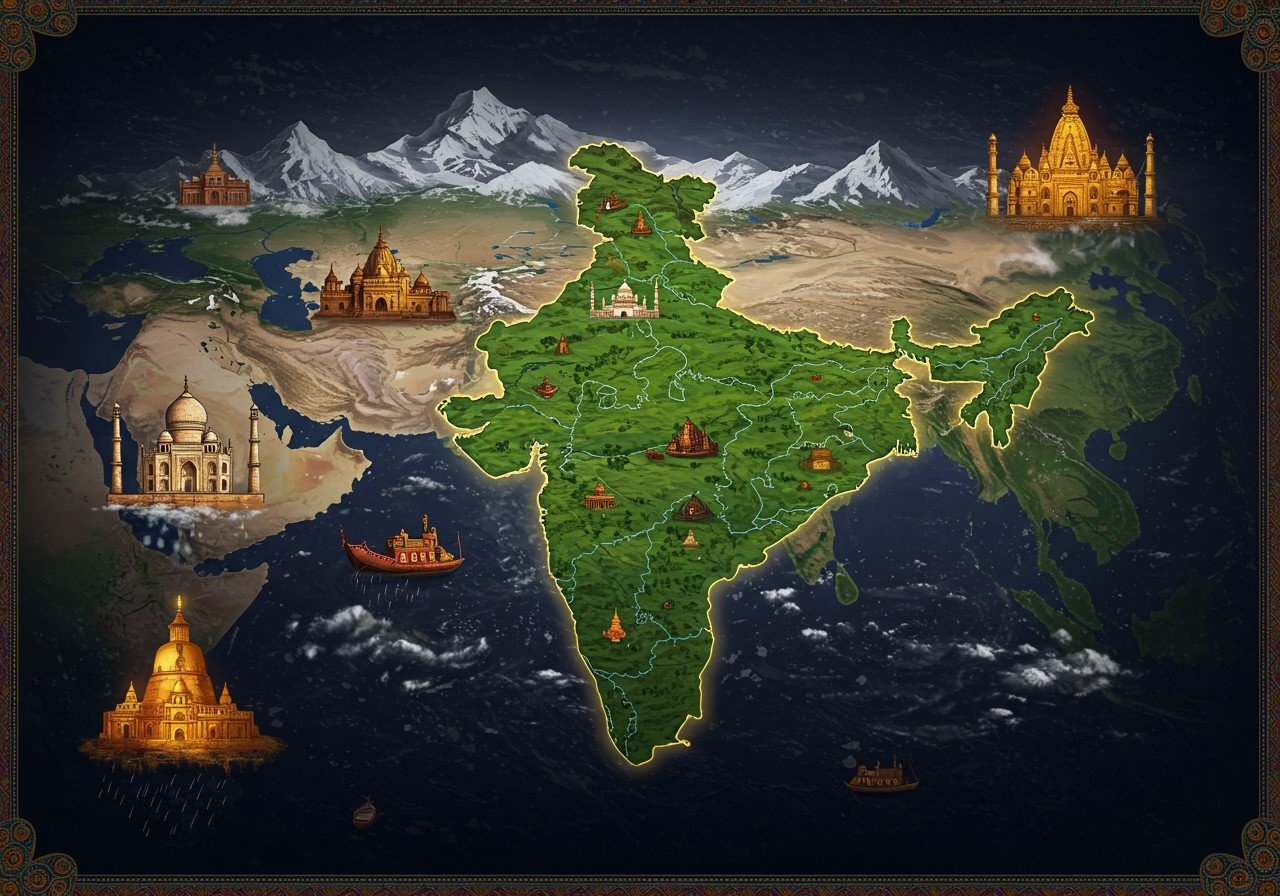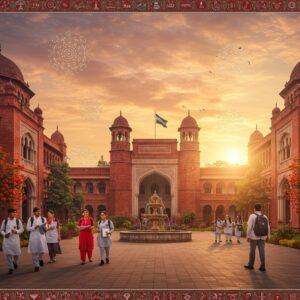
The Indian subcontinent, a geographically diverse region nestled below the Himalayas, is a land of captivating contrasts and rich history. It stretches southwards, projecting into the Indian Ocean, bordered by the Bay of Bengal to the east and the Arabian Sea to the west. This landmass encompasses Bangladesh, India, and Pakistan, and is home to a staggering 1.8 billion people. Its unique geography, shaped by the Himalayas and the Hindu Kush mountain ranges, has not only cradled distinct civilizations but also provided natural barriers that fostered cultural continuity and offered protection from invasions.
Geography of the Indian Subcontinent
Diverse Landscapes
The Indian subcontinent boasts an array of landscapes, each with its own unique characteristics:
- The Himalayan Range: This majestic mountain range serves as a natural barrier, influencing weather patterns and providing a source for major rivers. The Himalayas also hold immense spiritual significance for various cultures, with many sacred sites located within their towering peaks. They are a popular destination for mountaineers and trekkers, offering breathtaking views and challenging climbs.
- Indo-Gangetic Plains: These fertile plains, formed by the Indus and Ganges rivers and their tributaries, are crucial for agriculture. They have been the cradle of ancient civilizations, supporting dense populations and contributing significantly to the subcontinent’s food production. The rich alluvial soil makes this region ideal for farming a variety of crops.
- The Thar Desert: Located in northwest India, the Thar Desert presents a unique ecosystem with its shifting sand dunes and sparse vegetation. It holds cultural importance, particularly in Rajasthan, with vibrant traditions and communities adapted to the harsh desert environment. The desert’s unique flora and fauna add to its ecological significance.
- Deccan Plateau: This vast plateau, formed by volcanic activity, dominates central and southern India. It is rich in minerals and influences the region’s topography. The plateau’s diverse landscapes range from forests to scrublands, supporting a variety of wildlife.
- Coastal Regions: The extensive coastlines along the Arabian Sea and Bay of Bengal are vital for trade, fishing, and transportation. They support diverse ecosystems, including mangroves and coral reefs. These coastal areas also face the impacts of climate change, such as rising sea levels and increased cyclone activity.
- Major Rivers: The Indian subcontinent is crisscrossed by major rivers like the Ganges, Yamuna, Brahmaputra, and Indus. These rivers are lifelines, supporting agriculture, providing water resources, and playing a central role in religious and cultural practices. They sustain vast populations and contribute to the region’s biodiversity.
- Island Territories: The Andaman & Nicobar Islands and Lakshadweep, located in the Bay of Bengal and Arabian Sea respectively, are known for their unique biodiversity and strategic importance. They offer pristine beaches, vibrant coral reefs, and rich marine life, attracting tourists and researchers alike.
Climate of the Indian Subcontinent
Varied Climatic Conditions
The Indian subcontinent experiences a wide range of climatic conditions:
- Tropical Climate: Southern India, Sri Lanka, and parts of Bangladesh experience tropical climates, characterized by warm temperatures throughout the year and high humidity. These regions are prone to monsoonal rains, which are essential for agriculture.
- Arid Climate: The Thar Desert and surrounding areas have arid and semi-arid climates with low rainfall and extreme temperatures. These harsh conditions have led to unique adaptations in the local flora and fauna.
- Monsoon Season: The monsoon season, from June to September, brings heavy rainfall across much of the subcontinent. It is vital for agriculture, replenishing water resources and impacting the economy. The monsoon’s timing and intensity are crucial for agricultural success.
- Himalayan Climate: The Himalayas experience a range of climates, from cold temperate to alpine, depending on altitude. These varying conditions support unique ecosystems and influence the lives of local communities.
- Western Disturbances: These weather patterns, originating in the Mediterranean region, bring winter rainfall to northern India, impacting agriculture and temperatures.
- Climate Change: The Indian subcontinent is vulnerable to the impacts of climate change, including melting glaciers, rising sea levels, and more frequent extreme weather events. These changes pose significant challenges to the region’s environment and population.
History and Culture of the Indian Subcontinent
A Rich Tapestry
The Indian subcontinent’s history is a rich tapestry of ancient civilizations, empires, and cultural exchanges. This historical depth has shaped the region’s vibrant cultural mosaic, visible in its languages, religions, festivals, arts, cuisine, clothing, and handicrafts. From the ancient Indus Valley Civilization (c. 3300-1300 BCE) to the Vedic period (c. 1500-500 BCE), and from the rise and fall of empires like the Mauryas and Guptas to the Mughal era (1526-1857), the subcontinent has witnessed remarkable historical transformations. This rich past is reflected in the region’s diverse architectural marvels, including ancient temples, imposing forts, and iconic structures like the Taj Mahal. The influence of various dynasties and empires is evident in the region’s art, music, and literature, showcasing a blend of indigenous and external influences.
Poojn.in recognizes and celebrates this rich cultural heritage by offering a wide range of products related to Indian traditions and rituals. Whether you are looking for puja items, religious texts, or traditional clothing, Poojn.in strives to be your one-stop shop for all your cultural needs. Explore our diverse collection and connect with the spiritual heart of India. Discover authentic Indian Sandal Incense Sticks and other traditional products at poojn.in.
Explore more about Indian culture and traditions through our informative blog posts:
- Hanuman’s Journey: Devotion, Strength, and Epic Tale
- Lord Rama: Ideal Leadership and Virtue
- Hindu Philosophy Explained: A Beginner’s Guide


